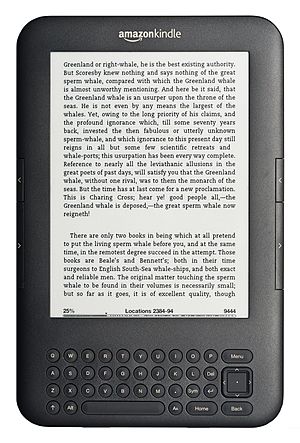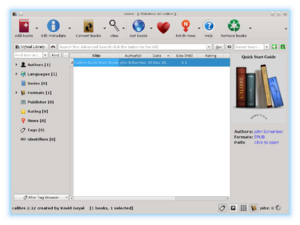E-reader facts for kids
An e-reader is a small electronic device made mainly for reading digital books, often called e-books, and magazines.
While many devices can show text, special e-readers are designed to be easy to carry, comfortable to read from, and have a long battery life. Their biggest advantage over paper books is how portable they are. An e-reader can hold thousands of books, but it weighs less than just one regular book! They also offer handy extra features.
Contents
What is an E-Reader?
An e-reader is a device created to make reading e-books simple and convenient. It looks a lot like a tablet computer. However, e-readers often use a special screen technology called "electronic paper" or "e-ink" instead of a regular LCD screen.
This e-ink screen has some cool benefits. It makes the battery last a very long time, sometimes for several weeks! It also makes reading much easier on your eyes, even in bright sunlight, just like reading from real paper. The main differences are that e-ink screens refresh slower and usually only show black and white. This means they aren't great for games or complex apps like tablets. But for reading, it helps you focus better on your book! The Sony Librie, released in 2004, was one of the first e-readers to use this electronic paper.
Many e-readers can connect to the internet using Wi-Fi. Their built-in software lets you link to online libraries or e-book stores. This way, you can easily buy, borrow, or download new digital books. You can also sometimes add e-books from a computer or a memory card, though fewer e-readers use memory cards these days.
The Story of E-Readers
The idea of a machine for reading goes way back! In 1930, a writer named Bob Brown imagined a "simple reading machine." He described it as something you could carry around, plug in, and read huge novels very quickly. He thought it might use tiny text on a film that you could scroll through and even change the text size.
A big step forward happened in 1997 with the creation of the E Ink Corporation. They developed "electronic paper." This technology allows screens to reflect light like regular paper, so they don't need a bright backlight. Some of the first e-readers to use this new paper were the Sony Librie in 2004 and the Sony Reader in 2006.
Then came the Amazon Kindle in 2007. It was incredibly popular, selling out in just a few hours after its release! The Kindle also gave users easy access to the Kindle Store to buy and download e-books. Other companies soon joined in, like Barnes & Noble Nook.
In 2010, Apple Inc. launched the iPad, a multi-function tablet computer. The iPad came with an app called iBooks and its own store for e-books. Soon, other companies released their own tablets. These tablets were different because they could do many things, not just read books. They had colorful LCD touchscreens and let you install different e-book apps. This meant you could read books from various stores on one device.
The rise of these versatile tablets led to a decrease in sales of dedicated e-readers around 2012. Many people preferred a device that could read books *and* do other things like browse the internet or play games. However, dedicated e-readers still have a loyal following because of their unique e-ink screens and long battery life.
A fun fact: Until late 2013, you couldn't use e-readers on airplanes during takeoff and landing. But in November 2013, rules changed, and now you can use them all the time if they are in Airplane Mode!
Reading Apps for All Devices
You don't always need a special e-reader device to enjoy digital books! Many big book stores and app developers offer e-reader applications. These apps let you read e-books and other documents on your regular computers, tablets, and smartphones.
You can find e-reader apps for computers running Linux, MacOS, and Windows. There are also apps for smartphones and tablets that use Android, iOS and Windows Phone. This means you can carry your favorite books with you on almost any device!
Why E-Readers are Great
E-readers have brought exciting changes to how we read. They offer many benefits:
- Huge Library in Your Hand: E-readers can store thousands of books. Your entire library can fit into one small device, taking up no more space than a single paper book.
- Easy on the Eyes: Most e-ink screens don't have a backlight. This means they feel just like reading a traditional book and cause less eye strain than bright computer or phone screens.
- Long-Lasting Battery: Because e-ink uses very little power, e-readers can go for weeks on a single charge.
- Customizable Reading: You can easily change the font size and spacing on an e-reader. This is super helpful for people who have trouble reading small print or have dyslexia.
- Instant Definitions: Many e-readers let you tap on a word to instantly see its definition or even translate it. Amazon notes that many of its e-reader users look up words while reading!
- Borrow from the Library: You can instantly download books from many public libraries using apps like OverDrive directly on your e-reader.
Popular E-Reader Brands
Here are some well-known e-reader brands and their popular models:
- Amazon (Global): Kindle, Kindle Paperwhite, Kindle Voyage, Kindle Oasis, Kindle Oasis 2, Kindle Scribe
- Barnes & Noble (US/UK): Nook, Nook GlowLight, Nook GlowLight Plus
- Bookeen (France): Cybook Opus, Cybook Orizon, Cybook Odyssey, Cybook Odyssey HD FrontLight
- Kobo (Global): Kobo Touch, Kobo Glo, Kobo Mini, Kobo Aura, Kobo Aura HD
- Onyx Boox (Europe, Russia, China and Vietnam): Onyx Boox Max2, Onyx Boox Note
- PocketBook (Europe and Russia): PocketBook Touch, PocketBook Mini, PocketBook Touch Lux, PocketBook Color Lux, PocketBook Aqua
- Tolino (Germany): Tolino Shine, Tolino Shine 2 HD, Tolino Vision, Tolino Vision 2
Other Ways to Read E-Books
Besides dedicated e-readers, you can also read e-books on other devices:
- Apple: iPad and iPad Mini (multi-function tablets)
- Amazon: Fire Tablet (multi-function tablets)
- Android based tablets (many different brands)
See also
 In Spanish: Lector de libros electrónicos para niños
In Spanish: Lector de libros electrónicos para niños
- Comparison of e-readers
- Supporting platforms for e-book formats
- Open Publication Distribution System



